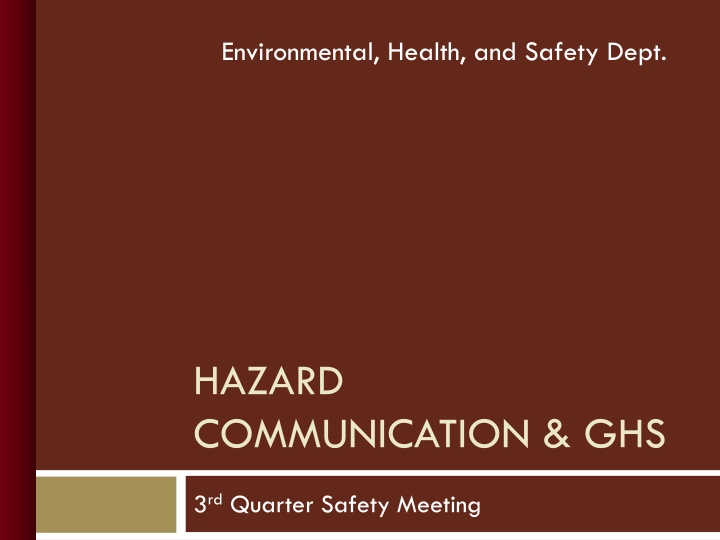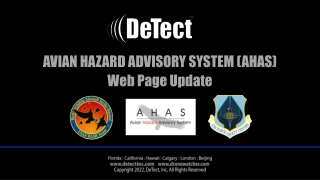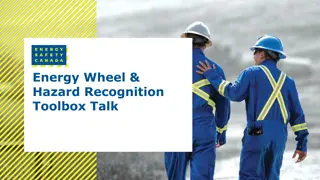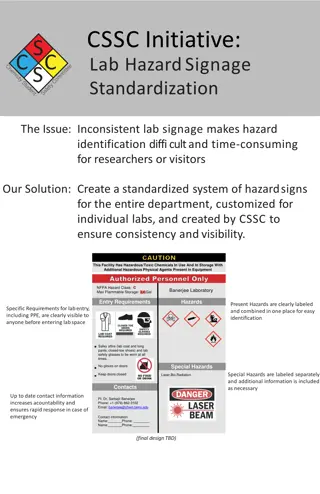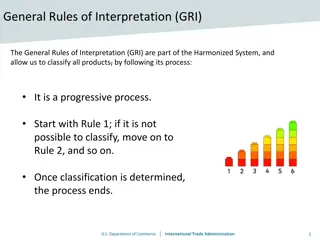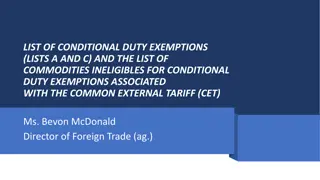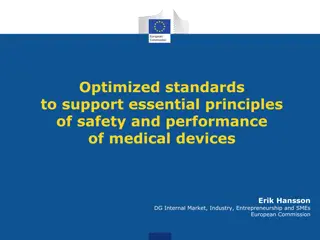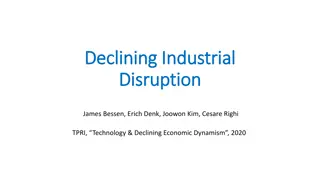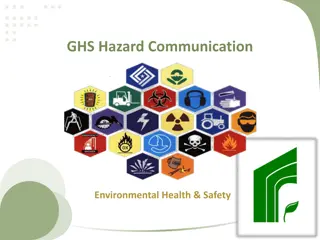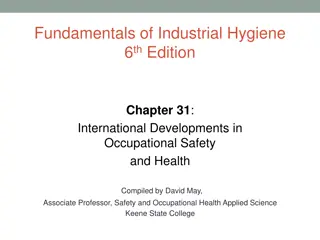Global Harmonized System (GHS) in Hazard Communication and Safety
The Global Harmonized System (GHS) establishes a uniform classification and labeling of chemicals to ensure effective communication of hazards globally. Developed to improve chemical management and safety, GHS aims to provide consistent protection and reduce regulatory burdens. Adopted internationally in 1992, GHS history shows its evolution and adoption by regulatory bodies like OSHA. Its implementation aligns hazard communication standards across industries for safer chemical handling.
Download Presentation

Please find below an Image/Link to download the presentation.
The content on the website is provided AS IS for your information and personal use only. It may not be sold, licensed, or shared on other websites without obtaining consent from the author.If you encounter any issues during the download, it is possible that the publisher has removed the file from their server.
You are allowed to download the files provided on this website for personal or commercial use, subject to the condition that they are used lawfully. All files are the property of their respective owners.
The content on the website is provided AS IS for your information and personal use only. It may not be sold, licensed, or shared on other websites without obtaining consent from the author.
E N D
Presentation Transcript
Environmental, Health, and Safety Dept. HAZARD COMMUNICATION & GHS 3rdQuarter Safety Meeting
GHS Globally Harmonized System of Classification & Labeling of Chemicals
GHS A system for standardizing and harmonizing the classification and labeling of chemicals Defines health, physical and environmental hazards of chemicals Communicates hazard information, as well as protective measures, on labels and Safety Data Sheets (SDS).
Current Systems Differences in systems within different countries and within different regulatory agencies within the same government leads to inconsistent protection for those potentially exposed to the chemicals as well as creating extensive regulatory burdens on companies producing chemicals
GHS The GHS itself is not a regulation or a standard Establishes agreed hazard classification and communication provisions with explanatory information on how to apply the system
Why Was GHS Developed? To provide sound management of chemicals that includes a system through which chemical hazards are identified and communicated to all who are potentially exposed
International Mandate Adopted in the 1992 United Nations Conference on Environment and Development (UNCED), often called the "Earth Summit". It was recognized that an internationally harmonized approach to classification and labeling would provide the foundation for all countries to develop comprehensive national programs to ensure the safe use of chemicals.
GHS History GHS formally adopted by the UN Committee of Experts - The Transport of Dangerous Goods and GHS in December 2002 OSHA ANPR on GHS 2006 OSHA NPRM on GHS 2009
GHS History OSHA revised the Hazard Communication Standard, aligning it with the GHS March 26, 2012 Rule effective 60 days after publication in the Federal Register Estimated to prevent 43 fatalities and 521 injuries & illnesses annually
Implementation Employers must complete all training regarding new label elements and SDS format by Dec 1, 2013 Requiring compliance with all provisions for preparation of new labels and SDS by June 1, 2015 Distributors can t ship containers unless they have a GHS label by Dec 1, 2015 Employers given an additional year, June 1, 2016 to update their Hazard Communication programs or any other workplace signs, if applicable
Application of GHS Enhance the protection of human health and the environment by providing an internationally comprehensible system Provide a recognized framework to develop regulations for those countries without existing systems Facilitate international trade in chemicals whose hazards have been identified on an international basis Reduce the need for testing and evaluation against multiple classification systems
Overall Benefits of GHS To ensure that employers, employees and the public are provided with adequate, practical, reliable and comprehensible information on the hazards of chemicals, so that they can take effective preventive and protective measure for their health and safety
Benefits to Workers/Public Improved safety for workers and others through consistent and simplified communications on chemical hazards and practices to follow for safe handling and use, Greater awareness of hazards, resulting in safer use of chemicals in the workplace and in the home
GHS & Existing Regulations The specific hazard criteria, classification processes, label elements and SDS requirements within an existing regulation will need to be modified to be consistent with the harmonized elements of the GHS ALL existing hazard communication systems will need to be changed in order to apply the GHS
Classification Classification is the starting point for hazard communication Involves the identification of the hazard(s) of a chemical or mixture by assigning a category of hazard/danger using defined criteria
Hazard Classes 16 classes of physical hazards 10 classes of health hazards 3 classes of environmental hazards
GHS Physical Hazards Explosives Flammable Gases Flammable Aerosols Oxidizing Gases Gases Under Pressure Flammable Liquids Flammable Solids Self-Reactive Substances Pyrophoric Liquids Pyrophoric Solids Self-Heating Substances Substances which, in contact with water emit flammable gases Oxidizing Liquids Oxidizing Solids Organic Peroxides Corrosive to Metals
GHS Health Hazards Acute Toxicity Skin Corrosion/Irritation Serious Eye Damage/Eye Irritation Respiratory or Skin Sensitization Germ Cell Mutagenicity Carcinogenicity Reproductive Toxicology Target Organ Systemic Toxicity - Single Exposure Target Organ Systemic Toxicity - Repeated Exposure Aspiration Toxicity
GHS Environmental Hazards Hazardous to the Aquatic Environment Acute aquatic toxicity Chronic aquatic toxicity Bioaccumulation potential Rapid degradability http://library.thinkquest.org/07aug/01628/P8243592.JPG
GHS Hazard Communication Once a chemical has been classified, the hazard(s) must be communicated to target audiences Labels and Safety Data Sheets are the main tools for chemical hazard communication
GHS Label Elements Product Identifier Signal Word (Danger, Warning) Hazard Statement (for each hazard class and category) Pictogram(s) Precautionary Statement (for each hazard class and category) Name, Address and Tele. # of chemical manufacturer
Signal Words "Danger" or "Warning" are used to emphasize hazards and indicate the relative level of severity of the hazard, assigned to a GHS hazard class and category. "Danger" for the more severe hazards "Warning" for the less severe hazards.
Hazard Statement Hazard statements are standardized and assigned phrases that describe the hazard(s) as determined by hazard classification Causes eye irritation Toxic if inhaled Flammable aerosol May cause cancer May cause respiratory irritation Harmful to aquatic life Contains gas under pressure; may explode if heated
Symbols/Pictograms Convey health, physical and environmental hazard information, assigned to a GHS hazard class and category. The GHS symbols have been incorporated into pictograms for use on the GHS label Pictograms will have a black symbol on a white background with a red diamond frame
Health Hazard Carcinogen Mutagenicity Reproductive Toxicity Respiratory Sensitizer Target Organ Toxicity Aspiration Toxicity
Environment Aquatic toxicity
Exclamation Mark Irritant (skin and eye) Skin Sensitizer Acute Toxicity Narcotic Effects Respiratory Tract Irritant Hazardous to Ozone Layer (Non- Mandatory)
Skull & Crossbones Acute toxicity (fatal or toxic)
Gas Cylinder Gases Under Pressure
Corrosion Skin Corrosion/Burns Eye Damage Corrosive to Metals
Exploding Bomb Explosives Self-Reactives Organic Peroxides
Flame Over Circle Oxidizers
Flame Flammables Pyrophorics Self-Heating Emits Flammable Gas Self-Reactives Organic Peroxides
Precautionary Statements Precautionary Statements are standardized explanations of the measures to be taken to minimize or prevent adverse effects Prevention Wear protective gloves Response If inhaled remove person to fresh air Storage Store in well ventilated place Disposal Waste must be disposed of in accordance with federal, state and local environmental control regulations - - - - - - - -
NFPA Label Changes Classification Flammable liquids are classified in one of four categories, as follows: Category 1 flashpoint of < 23 C and initial boiling point 35 C Category 2 flashpoint of < 23 C and initial boiling point > 35 C Category 3 flashpoint of 23 C and 60 C Category 4 flashpoint of > 60 C and 93 C Hazard Communication Category 1 Flame symbol with the Danger signal word Category 2 Flame symbol with the Danger signal word Category 3 Flame symbol with the Warning signal word Category 4 No symbol necessary, but must have the Warning signal word
Secondary Containers Employers must ensure that each container of hazardous chemicals in the workplace is labeled, tagged, or marked with either the information specified under (i) through (v) for labels on shipped containers (i) Product identifier; (ii) Signal word; (iii) Hazard statement(s); (iv) Pictogram(s); (v) Precautionary statement(s); OR
Secondary Containers Product identifier and words, pictures, symbols, or combination thereof, which provide at least general information regarding the hazards of the chemicals, and which, in conjunction with the other information immediately available to employees under the hazard communication program, will provide employees with the specific information regarding the physical and health hazards of the hazardous chemical.
MSDSs Information that is currently required on a MSDS: Identity used on the label Physical & chemical characteristics Physical hazards Health hazards Primary routes of entry Exposure limits Carcinogenic information Safe handling Control measures (PPE) Emergency & First Aid procedures Date of preparation Chemical mfg. contact info
Safety Data Sheets (SDS) Identification of the substance or mixture and of the supplier Hazards identification Composition/information on ingredients First aid measures Firefighting measures Accidental release measures Handling and storage Exposure controls/personal protection Physical and chemical properties Stability and reactivity Toxicological information Ecological information Disposal considerations Transport information Regulatory information Other information including information on preparation and revision of the SDS 1. 2. 3. 4. 5. 6. 7. 8. 9. 10. 11. 12. 13. 14. 15. 16.
Section 1 Substance & Supplier Identification Identifies the chemical on the SDS as well as the recommended uses. It also provides the essential contact information of the supplier: Product identifier used on the label and any other common names or synonyms by which the substance is known. Name, address, phone number of the manufacturer, importer, or other responsible party, and emergency phone number.
Section 2- Hazards Identification Identifies the hazards of the chemical presented on the SDS and the appropriate warning information associated with those hazards: The hazard classification of the chemical Signal word. Hazard statement(s). Pictograms Precautionary statement(s) Description of any hazards not otherwise classified
Section 3 Composition/Information on Ingredients Identifies the ingredient(s) contained in the product. This section includes information on substances, mixtures, and all chemicals where a trade secret is claimed: Chemical name Common name and synonyms For mixtures, the chemical name and concentration (i.e., exact percentage) of all ingredients which are classified as health hazards Chemical Abstracts Service (CAS) number and other unique identifiers.
Section 4 First Aid Measures Describes the initial care that should be given by untrained responders to an individual who has been exposed to the chemical: Necessary first-aid instructions by relevant routes of exposure (inhalation, skin and eye contact, and ingestion). Description of the most important symptoms or effects, and any symptoms that are acute or delayed. Recommendations for immediate medical care and special treatment needed, when necessary.
Section 5 Fire Fighting Measures Provides recommendations for fighting a fire caused by the chemical: Recommendations of suitable extinguishing equipment, and information about extinguishing equipment that is not appropriate for a particular situation. Advice on specific hazards that develop from the chemical during the fire, such as any hazardous combustion products created when the chemical burns. Recommendations on special protective equipment or precautions for firefighters.
Section 6 Accidental Release Measures Provides recommendations on the appropriate response to spills, leaks, or releases, including containment and cleanup practices to prevent or minimize exposure to people, properties, or the environment: Use of personal precautions and protective equipment Emergency procedures, and appropriate protective clothing Methods and materials used for containment Cleanup procedures (e.g., appropriate techniques for neutralization, decontamination, cleaning or vacuuming; adsorbent materials; and/or equipment required for containment/clean up)
Section 7 Handling & Storage Provides guidance on the safe handling practices and conditions for safe storage of chemicals: Precautions for safe handling, including recommendations for handling incompatible chemicals, minimizing the release of the chemical into the environment, and providing advice on general hygiene practices (e.g., eating, drinking, and smoking in work areas is prohibited) Recommendations on the conditions for safe storage, including any incompatibilities
